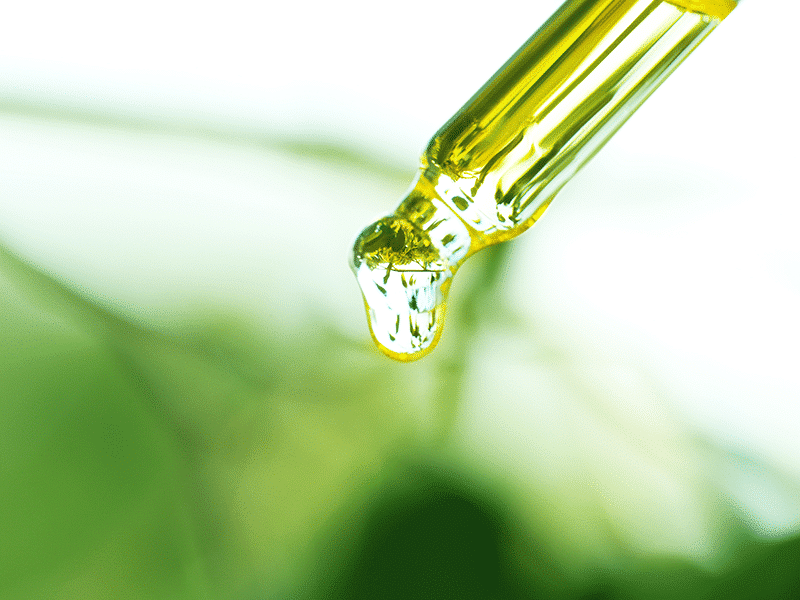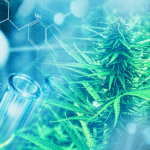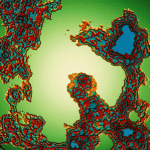In the last five years, the world has fallen in love with cannabidiol (CBD). Perhaps the biggest uptake has been in countries like the UK and United States where almost 10% of the population admit to having tried CBD oil. Most people probably assume that the cannabis or hemp plants used to make their CBD products can be found dripping in the magic molecule. But, actually, that’s not the case.
Cannabidiolic acid (CBDA) – the botanical precursor of CBD – is what’s found in fresh raw cannabis and hemp. CBD only comes into being when its acidic counterpart is exposed to heat.
Outside the inner sanctum of cannabinoid science, CBDA hasn’t gotten the column inches enjoyed by its botanical sibling. Indeed, for many years CBDA was mistakenly assumed to be an inactive compound. This notion – combined with CBDA’s instability whereby over time it begins to degrade – meant that scientific research into CBD’s acidic form has been fairly limited.
But CBDA is now undergoing a renaissance of sorts with increased media interest thanks to the launch of a patented CBDA “ester” (an intriguing molecular variant of CBD) and a host of positive anecdotal accounts of CBDA’s efficacy from medical cannabis patients and doctors.
What is CBDA?
Cannabidiolic acid was first isolated by Israeli scientist Raphael Mechoulam in 1965.1 Through exposure to sufficient heat or sunlight, CBDA changes into CBD by going through a chemical process called decarboxylation in which the carboxyl group is lost.
While many of us associate decarboxylation with cannabis, the same chemical reaction occurs in cellular respiration. It’s the reason we all exhale CO2 as a byproduct of metabolism.
For many years, decarboxylated cannabinoids were considered the ‘activated’ compounds, producing more potent therapeutic effects in our bodies. However, this assumption has recently been turned upside down with studies showing CBDA’s activation of 5-HT1A serotonin receptors to be significantly more potent than CBD. And CBDA was also shown to have a stronger binding affinity than CBD as an antagonist at another important receptor known as GPR55.
These discoveries suggested that CBDA could indeed have an important place at the therapeutic table for conditions as varied as cancer, anxiety, epilepsy, and treatment-resistant nausea and vomiting.
CBDA for Nausea & Vomiting
Serotonin is perhaps the most widely known class of neurotransmitter due to its role in mood regulation. However, serotonin’s biological reach extends far beyond just keeping us happy. It is involved in such diverse physiological functions as nausea, vomiting, and intestinal movements.
Much of what we know about CBDA’s activation of 5-HT1A serotonin receptors is thanks to research by Erin Rock and her team at Guelph University in Ontario, led by neuroscientist Linda Parker. Rock examined the therapeutic application of both CBD and CBDA for different types of nausea and vomiting.2 She showed that by binding with 5-HT1A receptors in a more potent fashion than CBD, CBDA suppressed nausea and vomiting caused by toxins and motion sickness.
Perhaps the most exciting breakthrough relates to CBDA’s remarkable success in reducing anticipatory nausea – the type of intense nausea one experiences prior to chemotherapy when patients feel horrible before treatment has even begun. Anticipatory nausea, it should be noted, has no effective pharmaceutical treatment.
In a different study examining the efficacy of combining CBDA with ondansetron, a standard antiemetic drug, Rock’s team found that even at very low doses CBDA enhanced the pharmaceutical drug’s anti-nausea effect.3 In fact, Rock goes on to assert that the amount of CBDA needed to reduce nausea was a staggering 1000 times less than required by CBD to have the same effect.
Furthermore, the Canadian scientists confirmed that CBDA is not intoxicating or impairing as it does not interact with CB1 cannabinoid receptors. This makes CBDA potentially a better option for patients who struggle with the mood-altering effects of THC-rich cannabis or dronabinol (FDA-approved synthetic THC).
CBDA & Epilepsy
CBD burst into the mainstream largely because of its celebrated anti-seizure effects. To date, the only approved CBD pharmaceutical in the United States is the purified CBD tincture, Epidiolex, for three types of drug-resistant epilepsy.
It’s not surprising that GW Pharma, the company behind Epidiolex, is looking closely at CBDA’s therapeutic potential. In pharmacokinetic studies comparing CBDA with CBD, GW scientists found CBDA to have superior bioavailability and faster onset than CBD – properties that make CBDA a very attractive option for drug development.
Not only did it require lower doses (thus reducing the chance of side effects), but CBDA was more effective in seizure reduction in certain parameters. Some of this data appears in GW’s patent application4 for the ‘Use of cannabinoids in the treatment of epilepsy,’ rather than in a peer reviewed study. But it certainly backs up Rock’s findings, as well as anecdotal reports coming from U.S. cannabis clinicians such as Bonni Goldstein and Dustin Sulak, who’ve had great success when treating patients with CBDA.
A Case History
Peruvian physician Max Alzamora shared a compelling case study involving CBDA in a recent Society of Cannabis Clinicians webinar.
14-year-old Glendy came into his office having 10 seizures a day due to autoimmune encephalitis. Prior to seeing Dr. Alzamora, she had at one point been in a medical coma for 45 days. She also contracted drug-induced hepatitis, which was caused by medication she’d been prescribed.
Glendy’s parents acquired CBD oil from the United States, which brought about some seizure reduction. However, buying imported CBD oil wasn’t financially viable for the family, so Dr. Alzamora found a local source of CBD oil. Or so he thought.
It turns out, the CBD oil hadn’t been decarboxylated, and Glendy was in fact taking CBDA. This was later confirmed when the oil was sent off for analysis in a Californian lab. And guess what – her seizures reduced even further. In fact, at latest count, Glendy, now 16, only has ten seizures a year and no longer takes any pharmaceutical anti-epileptic drugs. Her cognitive development, anxiety, autistic-like behaviour, and overall quality of life have all markedly improved since switching to the CBDA oil.
“While I was already getting good results in my patients with cannabinoid treatments containing THC and CBD,” says Dr. Alzamora, “CBDA has been especially effective in treating epilepsy, Parkinson’s, and inflammatory conditions. For me, the acidic cannabinoids open a whole spectrum of therapeutic possibilities.”
But medical scientists still have much to learn about CBDA’s multiple mechanisms of action with respect to epilepsy and other conditions. “I personally will be gathering more evidence that I hope will benefit patients,” Alzamora asserts.
Anti-Inflammatory CBDA
With Glendy’s epilepsy caused by an autoimmune condition, it’s possible her positive response to CBDA in part could be attributable to the acid cannabinoid’s anti-inflammatory action, which may occur because of its role as a selective Cox-2 inhibitor.5
There are two types of Cyclooxygenase (Cox) enzymes: Cox-1 maintains the normal lining of the stomach and intestines, and Cox-2 has a pro-inflammatory effect. Non-steroidal anti-inflammatory drugs, such as aspirin and ibuprofen, inhibit both Cox-1 and Cox-2 enzymes. By inhibiting Cox-1, long-term use of these over-the-counter drugs can cause major gastrointestinal complications.
It’s therefore of therapeutic interest to develop selective Cox-2 inhibitors that bypass Cox-1 and relieve patients’ inflammation-related symptoms, while sparing them of any dangerous long term consequences. As a Cox-2 inhibitor, CBDA shows potential as a safer non-steroidal anti-inflammatory drug, although studies have yet to be carried out on humans.
One preclinical study6 also found that CBDA’s downregulation of Cox-2 enzymes may help prevent the spread of a certain type of invasive breast cancer typified by higher than normal levels of Cox-2. When the breast cancer cells were treated with CBDA over 48 hours, both Cox-2 and Id-1, a protein associated with the aggressive spread of breast cancer cells, were down-regulated, while Sharp-1 expression, a suppressor of breast cancer metastasis, increased. Although this is very much preliminary data, it suggests that for certain types of breast cancer, CBDA may halt the spread of malignant cells to other parts of the body.
A Synthetic CBDA Compound
In the last few months, Professor Mechoulam has generated headlines once again with the launch of a patented synthetic CBDA methyl ester. With its chemical structure subtly altered to make the methyl ester compound more stable than CBDA, Mechoulam and his team have begun to investigate the compound’s therapeutic use in conditions such as anxiety, depression,7 inflammatory bowel disease, nausea and vomiting, and as an alternative to steroids.
While this stabilised version of CBDA may be easier to work with in the lab, particularly for the development of pharmaceutical drugs, it’s not at all clear that it represents a significant improvement as a therapeutic modality compared to artisanal cannabis or hemp products containing CBDA.
When stored appropriately in a cool, dark cupboard away from sunlight (or even the refrigerator in hot climates), CBDA does not tend to degrade if it is consumed within a few months. However, if you’ve got an opened CBDA bottle that’s been hanging around for a couple of years in direct sunlight, it probably won’t have the same cannabinoid profile it once had – and your carrier oil may have gone rancid.
Get Some CBDA in Your Life
For the conscious consumer trying to navigate today’s largely unregulated market, the presence of CBDA in a cannabis oil extract suggests that it’s likely a true full-spectrum product, rather than a formulation made from CBD isolate or distillate, both of which require heat to decarboxylate.
If you happen to have access to a few fresh cannabis leaves or flower tops, you may want to add some to a salad or smoothie. It’s an easy way to get acidic cannabinoids into your system. Or as Dr. Dustin Sulak recommended at the 2019 CannMed conference in Pasadena, try putting a small amount of raw CBDA-rich bud into a cup of steeping tea – the heat won’t be sufficient for decarbing and you’ll get the benefits of this hitherto neglected cannabis compound.
Indeed, it seems that after all these years of living in CBD’s shadow, CBDA is finally gaining recognition as a safe, and in some ways more potent, alternative to its famous cannabinoid relative. For those who are already taking CBD oil, or for those who are thinking about it, small doses of a CBDA-rich product may be worth considering.
Mary Biles, a UK-based journalist, educator, and Project CBD contributing writer, is the author of The CBD Book (Harper Collins, UK). © Copyright, Project CBD. May not be reprinted without permission.
Footnotes
- R Mechoulam et al. Hashish. IV. The isolation and structure of cannabinolic cannabidiolic and cannabigerolic acids. Tetrahedron 1965 May;21(5):1223-9
- EM Rock et al. Cannabidiolic acid prevents vomiting in Suncus murinus and nausea-induced behaviour in rats by enhancing 5-HT1A receptor activation. Br J Pharmacol. 2013 Mar; 168(6): 1456–1470
- EM Rock et al. Effect of low doses of cannabidiolic acid and ondansetron on LiCl-induced conditioned gaping (a model of nausea-induced behaviour) in rats. British journal of pharmacology vol. 169,3 (2013): 685-92.
- Use of cannabinoids in the treatment of epilepsy. Patent application. GW Pharma
- S Takeda et al. Cannabidiolic Acid as a Selective Cyclooxygenase-2 Inhibitory Component in Cannabis. Drug Metabolism and Disposition September 2008, 36 (9) 1917-1921
- S Takeda et al. Down-regulation of cyclooxygenase-2 (COX-2) by cannabidiolic acid in human breast cancer cells. The Journal of Toxicological Sciences. Vol.39, No.5, 711-716, 2014
- D Hen-Shoval et al. Acute oral cannabidiolic acid methyl ester reduces depression-like behavior in two genetic animal models of depression. Behav Brain Res 2018 Oct 1;351:1-3
Recommended Readings
Cannabinoids for Nausea
Preventing nausea is a common medical use of cannabis.
Dosing THCA: Less Is More
Discover the clinical and laboratory research on THCA for epilepsy, chronic pain, digestive disorders, and more.
Managing Nausea with Cannabis
CBD and CBDA interact with serotonin receptors to ease nausea and vomiting.











